Elizabeth Lev discusses history of Vatican museums
As one of the oldest and most popular art museums in the world, the Vatican draws throngs of people to gaze upon iconic works of art each year. As Elizabeth Lev pointed out, however, most of these people do not grasp the full history and meaning of what they see. Lev, an art historian and professor at the Pontifical University of St. Thomas Aquinas, gave a presentation at the Center for Ethics and Culture’s annual fall conference entitled “The Gift of the Magi: The Catholic Imagination and the Birth of the Modern Museum.”
Lev addressed the question of how thousands of works of art from various times and regions came together in one place—and why their home happens to be the center of Catholicism. She examined three popes—Julius II, Pius VI, and Pius XI—who spearheaded art collections and who, over time, built up “the world’s first modern museum.” She compared their contributions to the biblical “gifts of the Magi.” Lev explained, “They [gave] over a distance of centuries a series of different gifts that helped the museums to be put together, and it was this imagination that transformed a very good art collection belonging to a well-connected cardinal into what was essentially going to be museums as you and I know today.” She added that the method of organizing art collections during various papacies became the model for places like the Louvre and the British Museum.
The first pope of Lev’s examination, fifteenth century Julius II, spurred what Lev called “a redemptive imagination to works of the past.” Out of the Palazzetto Belvedere, a building originally meant for quiet meditation, Julius constructed his “octagonal garden,” where he arranged his collection of classical statues—including the famous Apollo Belvedere. Lev commented, “In this space, you would find all the possibilities for artists to be able to springboard into great art; they’d be able to think of new designs.” Among those new designs, she pointed out, were Christian works of art that drew inspiration from the ancient style. For example, she demonstrated how Michelangelo modeled the position of God the Father in his Separation of Light from Darkness after the contorted bodily position of the Laocoön. These inspirations, Lev argued, justified the pope’s decision to bring pagan statues into the Vatican, and they emphasized the redeemable nature of all forms of beauty.
Lev then explored the actions of eighteenth century Pius VI, who she claimed used art in the Vatican to communicate the “overarching Christian narrative.” This pontiff arranged areas such as the Hall of the Muses so that viewers could experience art in a “plausible original setting” and connect past with present. In addition, this storytelling function of art, Lev claimed, worked to draw together a diverse population. “This museum was to be a Catholic collection in the most ‘catholic’ sense of the word,” she said. “Everybody was invited. [In] 1784, the official dedication date, you find men, women, children … pets … [and even] Muslims from the Middle East.”
In this diverse setting, Lev continued, the beauty of art served as common ground for those who disagreed in other ways. For instance, although Pius VI maintained a tense relationship with King Gustave III of Sweden, at the Vatican museums, art became an “instrument of dialogue” for the two, allowing for more conciliatory discussion.
As Lev demonstrated, Pius VI’s arrangement of art emphasized the triumph of Christianity over paganism. In answer to the question of why the pontiff would display pieces from a world that persecuted Christians, Lev pointed to two items in the museum: Nero’s bowl and the sarcophagi of Helena and Constantina. The first belonged to one of the most terrible persecutors of Christianity, and the second encased the bodies of Christian empresses and saints. Both are made out of the same material, porphyry. This similarity, Lev explained, places the art into a “bigger narrative” in which the persecutors do not have the final word.
In the final section of her talk, Lev discussed the contributions of Pope Pius XI, whose papacy saw the end of the First World War and the dawn of the second. When it came to art, Lev said, he envisioned “a community that would be brought together through art and beauty.” In many ways, she explained, Pius XI spearheaded an “age of outreach” for the Vatican, from the launching of Vatican radio to the Missionary Exposition of art of 1925. Lev argued that, while he lacked the money and the far-reaching authority of the previously discussed popes, he still used art—especially through the construction of a new entrance and double helix staircase in 1932—as a way to promote unity and contemplation in the face of violence and fear.
As she concluded, Lev noted the disappointing transition from the Vatican museums as a place of aesthetic dialogue to a bustling zone of tourists seeking entertainment and photos. Still, she left her audience with the hopeful wonder of what the next “gift of the magi” for the museum will be. This reason to hope, according to Lev, comes from the conviction that among the modern audience, “They are all still looking for enchantment and grace.”
Sophia Buono is a junior PLS major and ESS minor. She had the great pleasure of visiting the Vatican museums nearly four years ago and plans to return this spring during Holy Week. If you are dying to join her quest, contact her at sbuono@nd.edu.

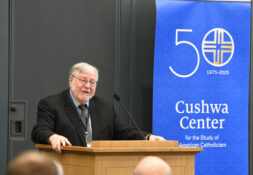
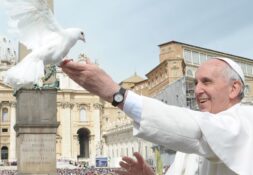
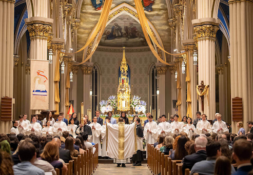
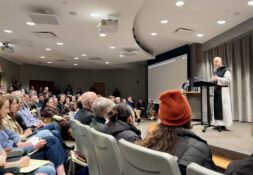
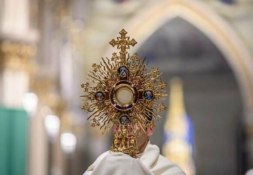

Leave a Reply